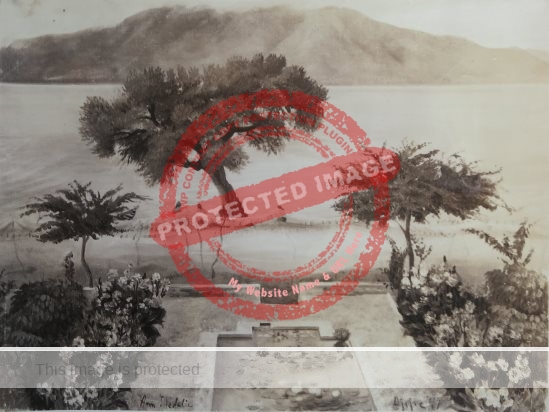What was Ajijic like 70 years ago? Well, a recently-found article by Zoe Kernick in Mexican Life gives us some tantalizing glimpses into life in the village back then.
A single overly-long sentence sets the scene and hints at some of the conflicts and contradictions that life in the village, even then, entailed:
For the pamphlet department, Ajijic is a quaint primitive village, full of fisherfolk; for Neill James, noted Petticoat Vagabond, it possesses the placidity of Paradise; for the tourist, it can be sometimes drab, though, if he becomes acquainted with certain of the residents, it can become an exultant drunken town; for the clergy of Guadalajara, an evil village, a place that Sunday parishioners must be warned against in scarlet words; for lovers, flowers trumpet against the patina of night-pink walls, remnants of rainfall glitter in the darkness, and from the Miradores, stately stars travel in ancient and tranquil paths over the lake; for some of us, who are formed by our own particular village vision, into a triple entente, Ajijic is a place of humor, a humor without logic, a witchcraft humor, where lights go on and off, where church bells ring for no apparent reason, where definitions can suddenly fly apart like a giant castillo with all its figures shooting off into the air.
Kernick lists several noted foreign residents, such as Pablo Heuer and his sister Louisa (“who run a pension which continues its primitive existence as though electricity and showers had never come to the village”), the ballerina La Russe, writer Neill James and the English couple, Herbert Johnson (“the village squire”) and his wife, Georgette.
She also writes a great deal about Mexican artist “Ernesto Linares” (real name Ernesto Butterlin) who, she informs readers,
“has known Ajijic since he was a small boy, week-ending with his family from Guadalajara…. A great deal of the spirit which guides the carnival gaiety of nightly fiestas, is due to Mr. Linares, for his competent hands are as deft with bottles as with brushes.”
Kernick offers a description of his recently opened store which “resembles a modern art gallery” and “sells hand-painted materials, pottery, leather goods” as well as paintings by village artists, including Linares, Nicolas Muzenic and Tobias Schneebaum.
The three artists are all involved in summer art classes for visitors from the US, and,
“As the bus with its twenty students and New York director, Mrs irma Jonas, rolled into Ajijic on the morning of July 10, 1949, it was met by the town lads in charro costume, pivoting about on their horses like Indians circling a caravan. The students were conducted to the Posada, rented for their stay, and then taken to a reception at the home of Mr. Linares. Everyone came to welcome them: the conglomerate foreign colonies of Ajijic and Chapala, the villagers, the charro lads. Martinis made music and mariachis made noise.”
Two oil paintings by Ann Medalie, the most striking of which is this unusual view across the lake (with the garden of Herbert and Georgette Johnson in the foreground) are used to illustrate Kernick’s article.

Ann Medalie. Ajijic Landscape (oil). ca 1945
Kernick rhapsodizes about the “spontaneous carnival spirit” of Ajijic, especially at fiesta time at the end of November when “castillos blaze at night in the plaza, spitting with great revolving wheels of silver sparks, golden fire; and dark Madonnas of parchment sail into the air.”
She is less enchanted with the local celebration of “Carnival,” when
“tired street oxen are herded into an arena where tequila-reeling men bite their tails to goad them into attitudes of fury; the whole town cheers on flimsy stands so crowded that both orchestra and audience are liable to imminent collapse. The Hero of each day is He Who Gets Gored, and each citizen contributes money to pay for the hero’s hospital bills, or for his funeral.”
On the other hand, she loves the Day of the Blessing of the Animals, when
“Every animal in the village, from bulls to pet doves, from pigs to cats to burros, to goats, are bathed and sprayed with perfume. Some of the animals are lovingly painted with color and always they are bowed in great satin pink and red ribbons. The animals are then led under the wall of the church where the priest stands, reading to them an imposing text, and scattering over their sweet heads his liquid dispensation. Things often get a trifle out of hand, as bulls start bellowing, armadillos run away, and spoiled cats climb up the priest’s robe.”
Things quietened down during the winter season, when
“Most of the entertaining is done en casa; supper parties on terraces beautiful with an arrangement of white flowers, white candles, women in long white gowns, silver sandals, and unfashionably long hair. The manner of living, graciously casual, inexpensive, yet fastidious, creates a fine fashion of its own.”
To avoid creating the wrong impression among her readers, Kernick takes pains to conclude that “All of this might be called a seed thrust of civilization; but Ajijic is not an art colony, and it is not a resort.”
Source
- Zoe Kernick. 1951. “Ajijic.” Mexican Life, April 1951, 13-14, 58, 60, 62-63.
Comments, corrections or additional material related to any of the writers and artists featured in our series of mini-bios are welcome. Please use the comments feature at the bottom of individual posts, or email us.
Tony Burton’s books include “Lake Chapala: A Postcard History” (2022), “Foreign Footprints in Ajijic” (2022), “If Walls Could Talk: Chapala’s historic buildings and their former occupants” (2020), (available in translation as “Si Las Paredes Hablaran”), “Mexican Kaleidoscope” (2016), and “Lake Chapala Through the Ages” (2008).